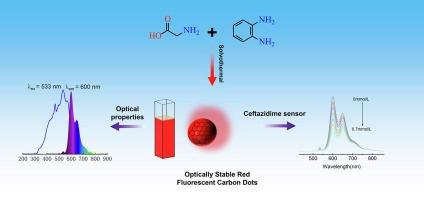Synthesis and application of optically stable red fluorescent carbon dots for sensitive and selective detection of ceftazidime
IF 4.3
2区 化学
Q1 SPECTROSCOPY
Spectrochimica Acta Part A: Molecular and Biomolecular Spectroscopy
Pub Date : 2024-10-26
DOI:10.1016/j.saa.2024.125341
引用次数: 0
Abstract
This study reports the successful synthesis of optically stable red-emitting carbon dots (R-CDs) through a solvothermal method, using glycine as the carbon source and o-phenylenediamine as the nitrogen-doping agent. The R-CDs exhibit long-wavelength emission characteristics with optimal excitation and emission wavelengths of 533 nm and 600 nm, respectively, and a quantum yield of 26.7 %. The results demonstrate that R-CDs possess excellent salt resistance and photostability. The R-CDs display bright fluorescence emission and show a sensitive response to ceftazidime (CF). Leveraging these properties, a fluorescent probe based on R-CDs was developed for the sensitive determination of CF. The fluorescence quenching intensity of this system exhibits a good linear relationship with CF concentration in the range of 0–0.7 mmol/L. The linear equation is (F0-F)/F0=0.9564CCF(mmol/L)+0.0089, with a linear correlation coefficient (R2) of 0.9945. The detection limit is 4.9 μmol/L, with recovery rates ranging from 94.2 % to 100.5 % and relative standard deviations between 2.2 % and 3.2 %. This work provides a theoretical basis for the detection of CF using red-emitting carbon dots and demonstrates promising potential for practical applications.

光学稳定的红色荧光碳点的合成与应用,用于灵敏、选择性地检测头孢他啶。
本研究以甘氨酸为碳源,邻苯二胺为氮掺杂剂,通过溶热法成功合成了光学稳定的红色发光碳点(R-CDs)。R-CD 具有长波长发射特性,最佳激发和发射波长分别为 533 纳米和 600 纳米,量子产率为 26.7%。研究结果表明,R-CD 具有优异的耐盐性和光稳定性。R-CD 显示出明亮的荧光发射,并对头孢他啶(CF)有灵敏的反应。利用这些特性,我们开发出了一种基于 R-CDs 的荧光探针,用于灵敏测定 CF。在 0-0.7 mmol/L 的范围内,该系统的荧光淬灭强度与 CF 浓度呈良好的线性关系。线性方程为 (F0-F)/F0=0.9564CCF(mmol/L)+0.0089, 线性相关系数 (R2) 为 0.9945。检测限为 4.9 μmol/L,回收率为 94.2 % 至 100.5 %,相对标准偏差为 2.2 % 至 3.2 %。这项工作为利用红色发光碳点检测 CF 提供了理论依据,并展示了实际应用的巨大潜力。
本文章由计算机程序翻译,如有差异,请以英文原文为准。
求助全文
约1分钟内获得全文
求助全文
来源期刊
CiteScore
8.40
自引率
11.40%
发文量
1364
审稿时长
40 days
期刊介绍:
Spectrochimica Acta, Part A: Molecular and Biomolecular Spectroscopy (SAA) is an interdisciplinary journal which spans from basic to applied aspects of optical spectroscopy in chemistry, medicine, biology, and materials science.
The journal publishes original scientific papers that feature high-quality spectroscopic data and analysis. From the broad range of optical spectroscopies, the emphasis is on electronic, vibrational or rotational spectra of molecules, rather than on spectroscopy based on magnetic moments.
Criteria for publication in SAA are novelty, uniqueness, and outstanding quality. Routine applications of spectroscopic techniques and computational methods are not appropriate.
Topics of particular interest of Spectrochimica Acta Part A include, but are not limited to:
Spectroscopy and dynamics of bioanalytical, biomedical, environmental, and atmospheric sciences,
Novel experimental techniques or instrumentation for molecular spectroscopy,
Novel theoretical and computational methods,
Novel applications in photochemistry and photobiology,
Novel interpretational approaches as well as advances in data analysis based on electronic or vibrational spectroscopy.

 求助内容:
求助内容: 应助结果提醒方式:
应助结果提醒方式:


